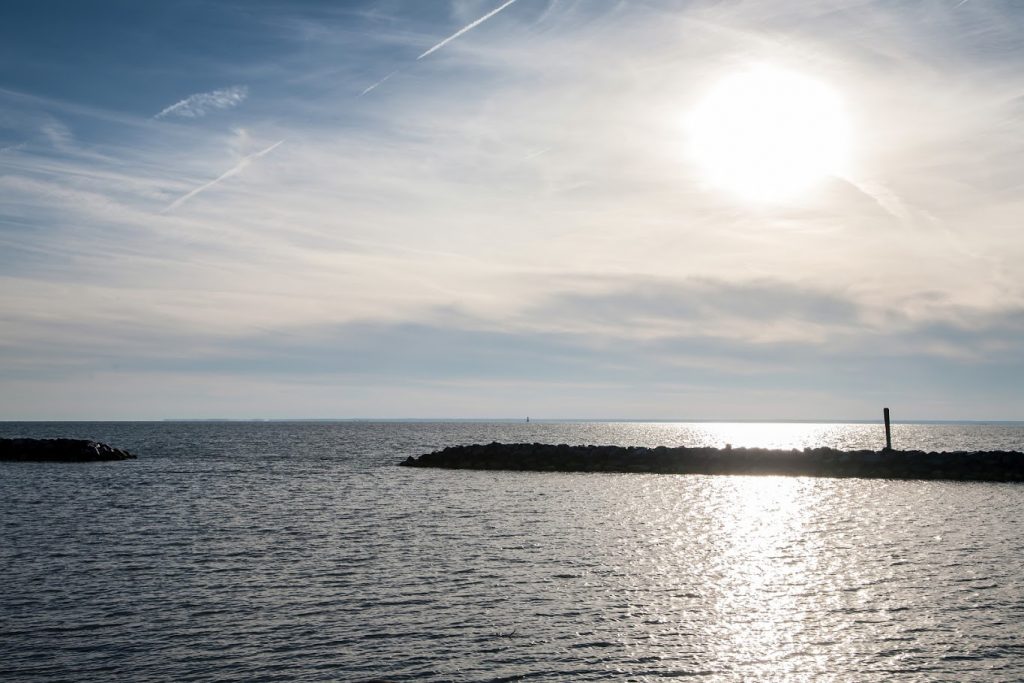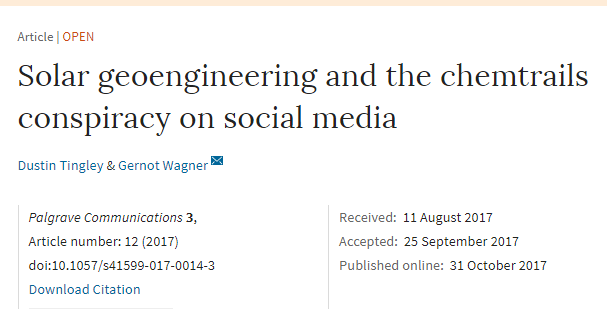3 November 2017
Twitter is Chem-trail Central
Posted by Dan Satterfield
We’ve reached a sad state when this explanation needs to be written at the beginning of a scientific paper:
Introduction
The story goes like this: tens of thousands of commercial airliners a day are deliberately spraying some kind of mixture of toxic chemicals—either across the United States or possibly globally—in what would amount to one of the largest covert operations ever. The scheme has been going on for years, perhaps decades (Thomas, 1999). The goal: everything from large-scale weather modification to mass population or mind control. The motive presumably would vary with the goal, but it is typically seen as a version of powerful business, government, and military interests covering up even worse deeds.

Jet contrail over the Chesapeake Bay. It’s water vapor and NOT a mind control chemical. Dan’s photo.
Except none of this is true.
“Chemtrails” are not real. The US Environmental Protection Agency says so (EPA, 2000). Scientists say so (Cairns, 2016; Shearer et al., 2016). An increasing number of investigative journalistic accounts say so (e.g., Dunne, 2017; Streep, 2008). Contrails, made up of water vapor, have been a byproduct of aviation ever since humans began to fly using jet engines (Pretor-Pinney and Sanderson, 2006).
The paper is here, but what alarms me is how prevalent the belief is that those white lines across the sky are secret government attempts at mind and or weather control. The paper points out that most of the conspiracy echo chamber bounces around on Twitter. Maybe that shouldn’t be a surprise since the U.S. House of Representatives Space, Science, Technology committee itself is one of the worst purveyors of silly conspiracy theories about atmospheric science.
The paper brings up the question of whether acknowledging this type of conspiracy thinking spreads it more widely, and I think that’s possible. My own feelings are that making fun of those who believe it’s true seems to work.
Read the paper, but the conclusion is below.
Conclusion
Chemtrails are not real. Belief in the chemtrails conspiracy is. Between ~ 30 and ~ 40% of the general US public appear to subscribe to versions of the conspiracy theory, numbers only topped by the large fraction (~ 60%) of social media discourse, more on Twitter, focused on the topic. That renders rational conversations around solar geoengineering and its potential role in climate policy even more difficult than it would be absent the chemtrails conspiracy (Burns et al., 2016). It also shows some of the broader implications of this online community of conspiracy with implications well beyond climate policy.
The widespread belief in these ridiculous theories is confirmation that we are not teaching critical thinking skills to high school students.
We must start.



 Dan Satterfield has worked as an on air meteorologist for 32 years in Oklahoma, Florida and Alabama. Forecasting weather is Dan's job, but all of Earth Science is his passion. This journal is where Dan writes about things he has too little time for on air. Dan blogs about peer-reviewed Earth science for Junior High level audiences and up.
Dan Satterfield has worked as an on air meteorologist for 32 years in Oklahoma, Florida and Alabama. Forecasting weather is Dan's job, but all of Earth Science is his passion. This journal is where Dan writes about things he has too little time for on air. Dan blogs about peer-reviewed Earth science for Junior High level audiences and up.
Contrails do affect local weather, however, by acting as man-made clouds. The action is similar to natural clouds.
According to research evidence based on the 3-day civilian air traffic shutdown after 9/11, the contrails will depress the diurnal temperature range. High temperatures will be lower, and night-time temperatures will be higher. Just like natural clouds.
This is just the conclusion one would reach if you thought through the process. This isn’t a conspiracy, just science.
Contrails are not water vapor. Water vapor is a gas and is invisible. Contrails are water droplets condensed from the water vapor.
Actually to be precise, ice crystals. Or frozen water vapour…
Oh, that darned dihydrogen oxide.